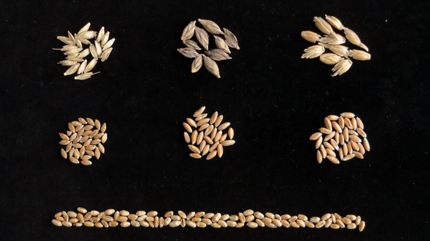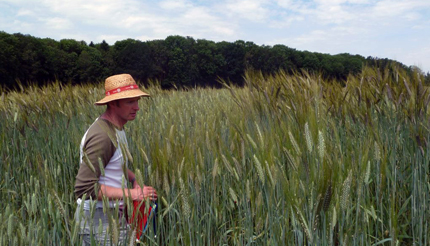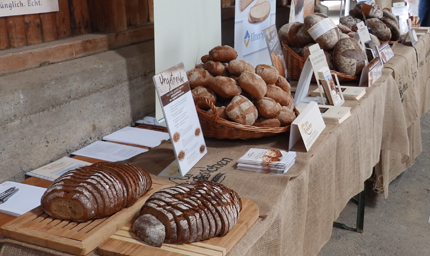5585 Guilford Road • Madison, WI 53711-5801 • 608-273-8080 • Fax 608-273-2021
www.agronomy.org
Twitter | Facebook
NEWS RELEASE
Contact: Hanna Jeske, Associate Director of Marketing and Brand Strategy, 608-268-3972, hjeske@sciencesocieties.org
Ancient going on nouveau
Jan. 13, 2016 - We've come a long way from the days of hunting and gathering. With advancements in science and technology, we're now a society that hunts for the best price and gathers coupons. Since less of our energy is going to finding and killing our next meal, we have time to be more discerning about the ingredients used in our food.

For many, this means getting "back to the basics," preferring items that are healthier and made with natural ingredients. Even the food pyramid encourages us to eat whole wheat over refined grains. Taking that advice, discerning consumers are seeking out alternatives to basic white bread. They are turning to Old World grains like spelt, emmer, and einkorn. However, reviving ancient grains in modern times isn't without its challenges.
That's where Friedrich Longin comes in. Longin is the head of the Wheat Group at the University of Hohenheim, Stuttgart, Germany. One of the Longin's goals is to evaluate the potential of old forgotten crops in modern agriculture. He hopes to learn more about how to best grow these grains on modern farms, and how to best use them in modern baking.
The group decided to compare the ancient grains spelt, emmer, and einkorn with the more common bread and durum wheat varieties. But it wasn't easy to get the research up and running. Because the grains are so old – emmer was the main cereal crop in Egypt during the time of the pharaohs – it took Longin and his team a couple of years to get enough seeds to plant their research fields. Once the fields were planted and growing, researchers studied the height of the plants in the fields, the amount of grain harvested from each crop, and the amount and quality of protein contained in the grains, among other things.
 They found that even with little fertilizer, emmer and einkorn plants were unfortunately tall. "Tall plant heights lead to a high risk of lodging" explains Longin. Lodging is when the stem of the grain breaks during a strong wind or storm because the ear is too heavy. Lodging reduces the yield and quality of the grains. Growers will need to keep the crops standing until harvest by using reduced fertilization, among other techniques.
They found that even with little fertilizer, emmer and einkorn plants were unfortunately tall. "Tall plant heights lead to a high risk of lodging" explains Longin. Lodging is when the stem of the grain breaks during a strong wind or storm because the ear is too heavy. Lodging reduces the yield and quality of the grains. Growers will need to keep the crops standing until harvest by using reduced fertilization, among other techniques.
They also found that the ancient grain crops did not yield as much as the common bread and durum wheat crops. And while the ancient grains contained high amounts of protein, the quality of the protein was not as good as in the modern crops. The amount and quality of protein in grains is important when using them for baking. Nevertheless, bakers can deliver premium products by using more traditional methods, such as low temperature dough preparation.
None of these findings discouraged Longin and his team. "We are happy that this research now delivers deep insights into the agronomic and quality performance of spelt, emmer, and einkorn" said Longin, especially because bringing back these ancient grains comes with additional perks. Adding these crops will enrich biodiversity, which largely reduces a crop’s vulnerability against disease, and reduce fertilizer and pesticide use in the fields.
 Additionally, these grains taste good and are good for you. Longin explains, "Spelt, emmer, and especially einkorn have a fuller aroma profile than bread wheat - slightly nutty, fine tasting, most often coupled with a fresher feeling in the breads. In beer, spelt, emmer and einkorn deliver a sounder and deeper aroma."
Additionally, these grains taste good and are good for you. Longin explains, "Spelt, emmer, and especially einkorn have a fuller aroma profile than bread wheat - slightly nutty, fine tasting, most often coupled with a fresher feeling in the breads. In beer, spelt, emmer and einkorn deliver a sounder and deeper aroma."
The grains are also rich in minerals. Einkorn even contains lutein, which is important for eyes and nervous systems.
Longin and his team have plenty of work ahead of them yet to establish these Old World grains in the New World. But farmers, millers, bakers, brewers, and consumers can look forward to these ancient grains becoming more growable, profitable, and available.
Longin’s research is published in Crop Science.
Crop Scienceis the flagship journal of the Crop Science Society of America. It is a top international journal in the fields of crop breeding and genetics, crop physiology, and crop production. The journal is a critical outlet for articles describing plant germplasm collections and their use.